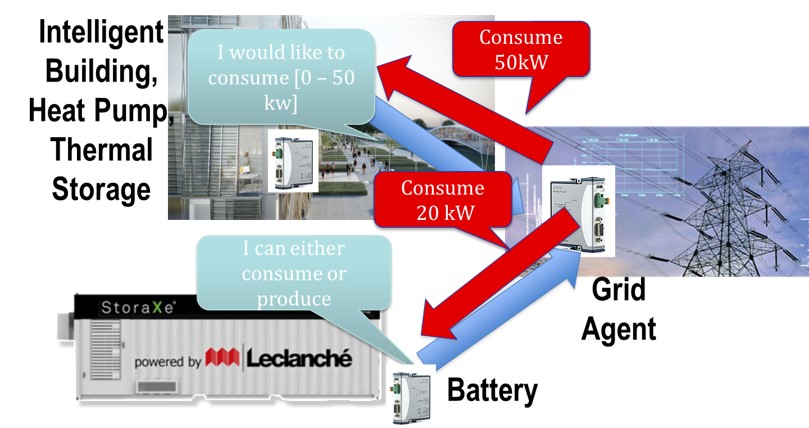How to integrate up to 100% of renewables into distribution grids?
What happens today if we add a very large amount of renewables to the electricity mix? First, many distribution grids face power quality problems such as over- and under-voltages and excessive line-currents. Second, the high volatility of renewables needs to be compensated by fuel-based conventional generators to maintain power balance at all times. Fortunately, these problems can be avoided by smart real-time control of power flows, and this is what the Commelec framework provides.
Commelec controls an electrical grid in real time, even if the grid has very little inertia, as is typical when there is a large amount of distributed generation. Its solves the problems of power quality and power balance without major investment. The framework is a “Grid Operating System” that allows device controllers for intelligent buildings with demand response, batteries, e-car charging systems, etc. to be easily connected while providing real-time support to the grid.
Slide show
Demonstration of Commelec on the EPFL Microgrid
Demonstration of Commelec at the EMPA NEST
Commelec in a Nutshell
The goal of Commelec is to directly control the targeted grid by defining explicit and real-time setpoints for active/reactive power absorptions/injections. This requires solving an optimization problem that quickly becomes intractable when systems are large or diverse. Commelec addresses this problem by:
1. A common abstract model and protocol. Resources advertise their state to a grid agent, using a device independent description. A
grid agent controls its resource using a single algorithm, common to all grid agents. The goal of this algorithm is to maintain
the system in safe state of operation while trying to satisfy the resources’ willingness to produce/absorb power.

2. An aggregation method, i.e. subsystems can be aggregated into virtual devices that hide their internal complexity. Thus the proposed method can easily cope with systems of any size or complexity.

The Commelec framework is presented in Part I, whilst in Part II we illustrate its application to a CIGRÉ low voltage benchmark microgrid. In particular, we provide implementation examples with respect to typical devices connected to distribution networks and evaluate of the performance and benefits of the proposed control framework.
- Andrey Bernstein, Lorenzo Reyes-Chamorro, Jean-Yves Le Boudec, Mario Paolone, A composable method for real-time control of active distribution networks with explicit power setpoints. Part I: Framework, Electric Power Systems Research, Available online 15 April 2015, ISSN 0378-7796, http://dx.doi.org/10.1016/j.epsr.2015.03.023.
- Lorenzo Reyes-Chamorro, Andrey Bernstein, Jean-Yves Le Boudec, Mario Paolone, A composable method for real-time control of active distribution networks with explicit power setpoints. Part II: Implementation and validation, Electric Power Systems Research, Available online 18 April 2015, ISSN 0378-7796, http://dx.doi.org/10.1016/j.epsr.2015.03.022.
Slide shows about Commelec from 2014: part 1, part 2
The NRP70 Commelec project is funded by the SNF “Energy Turnaround” program.
We have developed GECN (“Grid Explicit Congestion Notification”), a communication protocol that enables the control of a large number distributed resources for providing ancillary services to the grid (such as voltage control).
We are developing an API for COMMELEC so that anyone can write a Resource Agent that can ‘speak’ to our Grid Agent.
You can also view the results of our successful demonstration of COMMELEC.